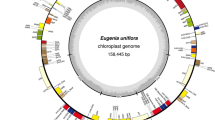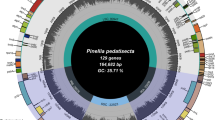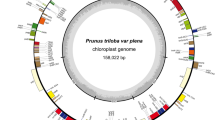Abstract
Background
Bursera trees are conspicuous elements of the tropical dry forests in the Neotropics that have significant cultural value due to their fragrant resins (incense), wood sources (handcrafts), and ecological benefits. Despite their relevance, genetic resources developed for the genus are scarce.
Methods and results
We obtained the complete chloroplast (Cp) genome sequence, analyzed the genome structure, and performed functional annotation of three Bursera species of the Bullockia section: Bursera cuneata, B. palmeri, and B. bipinnata. The Cp genome sizes ranged from 159,824 to 159,872 bp in length, including a large single-copy (LSC) region from 87,668 to 87,656 bp, a small single-copy (SSC) from 18,581 to 18,571 bp, and two inverted repeats regions (IRa and IRb) of 26,814 bp each. The three Cp genomes consisted of 135 genes, of which 90 were protein-coding, 37 tRNAs, and 8 rRNAs. The Cp genomes were relatively conserved, with the LSC region exhibiting the greatest nucleotide divergence (psbJ, trnQ-UCC, trnG-UCC, and petL genes), whereas few changes were observed in the IR border regions. Between 589 and 591 simple sequence repeats were identified. Analysis of phylogenetic relationships using our data for each Cp region (LSC, SSC, IRa, and IRb) and of seven species within Burseraceae confirmed that Commiphora is the sister genus of Bursera. Only the phylogenetic trees based on the SSC and LSC regions resolved the close relationship between B. bipinnata and B. palmeri.
Conclusion
Our work contributes to the development of Bursera’s genomic resources for taxonomic, evolutionary, and ecological-genetic studies.






Similar content being viewed by others
Data availability
The complete chloroplast sequence data that support the findings of this study have been deposited in NCBI GenBank: Bursera bipinnata: OR003920, Bursera cuneata: OR003921, and Bursera palmeri: OR003922.
References
McVaugh R, Rzedowski J (1965) Synopsis of the genus Bursera L. in Western Mexico, with notes on the material of Bursera collected by Sesse & Mocino. Kew Bull 18:317. https://doi.org/10.2307/4109252
Becerra JX (2003) Evolution of Mexican Bursera (Burseraceae) inferred from ITS, ETS, and 5S nuclear ribosomal DNA sequences. Mol Phylogenet Evol 26:300–309. https://doi.org/10.1016/S1055-7903(02)00256-7
Evans PH, Becerra JX, Venable DL, Bowers WS (2000) Chemical analysis of squirt-gun defense in Bursera and counterdefense by chrysomelid beetles. J Chem Ecol 26:745–754. https://doi.org/10.1023/A:1005436523770/METRICS
Rzedowski J, Medina Lemos R, Calderón de Rzedowski G (2005) Inventario Del conocimiento taxonómico, así como de la diversidad y del endemismo regionales de las especies mexicanas de Bursera (Burseraceae). Acta Bot Mex 70:85–111
Aurora Montufar L (2004) Identidad y simbolismo del copal prehispánico y reciente. Arqueología 60–71
CONABIO (2008) Copales, diversidad y cultura. Mexico
Daly DC (1993) Studies in neotropical Burseraceae. VII. Notes on Bursera in South America. Brittonia 45:240–246
Rzedowski J, Guevara-Féfer F (1992) Burseraceae. Flora del Bajío y de regiones adyacentes 3:46
Almazán-Núñez RC, Eguiarte LE, Arizmendi M et al (2016) P Myiarchus flycatchers are the primary seed dispersers of Bursera longipes in a Mexican dry forest. PeerJ. https://doi.org/10.7717/PEERJ.2126/TABLE-4
Stevenson PR, Link A, Ramírez BH (2005) Frugivory and seed fate in Bursera inversa (Burseraceae) at Tinigua Park, Colombia: implications for Primate Conservation1. Biotropica 37:431–438. https://doi.org/10.1111/J.1744-7429.2005.00057.X
Rivas-Arancibia SP, Bello-Cervantes E, Carrillo-Ruiz H et al (2015) Variaciones de la comunidad de visitadores florales de Bursera copallifera (Burseraceae) a lo largo de un gradiente de perturbación antropogénica. Rev Mex Biodivers 86:178–187. https://doi.org/10.7550/RMB.44620
Becerra JX (2005) Timing the origin and expansion of the Mexican tropical dry forest. Proc Natl Acad Sci U S A 102:10919–10923. https://doi.org/10.1073/PNAS.0409127102/ASSET/B5AB354D-F64E-4B99-BD00-48B8036D9D1C/ASSETS/GRAPHIC/ZPQ0280588260004.JPEG
de-Nova JA, Medina R, Montero JC et al (2012) Insights into the historical construction of species-rich mesoamerican seasonally dry tropical forests: the diversification of Bursera (Burseraceae, Sapindales). New Phytol 193:276–287. https://doi.org/10.1111/J.1469-8137.2011.03909.X
Becerra JX, Venable DL (1999) Nuclear ribosomal DNA phylogeny and its implications for evolutionary trends in Mexican Bursera (Burseraceae). Am J Bot 86:1047–1057. https://doi.org/10.2307/2656622
Rosell JA, Olson ME, Weeks A et al (2010) Diversification in species complexes: tests of species origin and delimitation in the Bursera simaruba clade of tropical trees (Burseraceae). Mol Phylogenet Evol 57:798–811. https://doi.org/10.1016/J.YMPEV.2010.08.004
Weeks A, Simpson BB (2004) Molecular genetic evidence for interspecific hybridization among endemic Hispaniolan Bursera (Burseraceae). Am J Bot 91:976–984. https://doi.org/10.3732/AJB.91.6.976
Rico Y, Lorenzana GP, Benítez-Pineda CA, Olukolu BA (2022) Development of genomic resources in Mexican Bursera (section: Bullockia: Burseraceae): Genome assembly, annotation, and marker discovery for three copal species. Genes. https://doi.org/10.3390/genes13101741
Khan A, Asaf S, Khan AL et al (2019) First complete chloroplast genomics and comparative phylogenetic analysis of Commiphora gileadensis and C. Foliacea: myrrh producing trees. PLoS ONE 14:e0208511. https://doi.org/10.1371/JOURNAL.PONE.0208511
Khan AL, Al-Harrasi A, Asaf S et al (2017) The first chloroplast genome sequence of Boswellia sacra, a resin-producing plant in Oman. PLoS ONE 12:e0169794. https://doi.org/10.1371/JOURNAL.PONE.0169794
Daniell H, Lin CS, Yu M, Chang WJ (2016) Chloroplast genomes: diversity, evolution, and applications in genetic engineering. Genome biology. https://doi.org/10.1186/S13059-016-1004-2
Ebert D, Peakall R (2009) Chloroplast simple sequence repeats (cpSSRs): technical resources and recommendations for expanding cpSSR discovery and applications to a wide array of plant species. Mol Ecol Resour 9:673–690. https://doi.org/10.1111/J.1755-0998.2008.02319.X
Figueroa-Suárez MZ, González Christen J, Cardoso-Taketa AT et al (2019) Anti-inflammatory and antihistaminic activity of triterpenoids isolated from Bursera Cuneata (Schldl.) Engl. J Ethnopharmacol 238:111786. https://doi.org/10.1016/J.JEP.2019.03.013
Healey A, Furtado A, Cooper T, Henry RJ (2014) Protocol: a simple method for extracting next-generation sequencing quality genomic DNA from recalcitrant plant species. Plant Methods 10:1–8. https://doi.org/10.1186/1746-4811-10-21/COMMENTS
Chen S, Zhou Y, Chen Y, Gu J (2018) Fastp: an ultra-fast all-in-one FASTQ preprocessor. Bioinformatics 34:i884–i890. https://doi.org/10.1093/BIOINFORMATICS/BTY560
Jin JJ, Yu W, Bin, Yang JB et al (2020) GetOrganelle: a fast and versatile toolkit for accurate de novo assembly of organelle genomes. Genome Biol 21:1–31. https://doi.org/10.1186/S13059-020-02154-5/FIGURES/6
Okonechnikov K, Golosova O, Fursov M et al (2012) Unipro UGENE: a unified bioinformatics toolkit. Bioinformatics 28:1166–1167. https://doi.org/10.1093/BIOINFORMATICS/BTS091
Shi L, Chen H, Jiang M et al (2019) CPGAVAS2, an integrated plastome sequence annotator and analyzer. Nucleic Acids Res 47:W65–W73. https://doi.org/10.1093/NAR/GKZ345
Zheng S, Poczai P, Hyvönen J et al (2020) Chloroplot: an online program for the Versatile Plotting of Organelle genomes. Front Genet 11:576124. https://doi.org/10.3389/FGENE.2020.576124/BIBTEX
Lehwark P, Greiner S (2019) GB2sequin - A file converter preparing custom GenBank files for database submission. Genomics 111:759–761. https://doi.org/10.1016/J.YGENO.2018.05.003
Frazer KA, Pachter L, Poliakov A et al (2004) VISTA: computational tools for comparative genomics. Nucleic Acids Res. https://doi.org/10.1093/NAR/GKH458
Amiryousefi A, Hyvönen J, Poczai P (2018) IRscope: an online program to visualize the junction sites of chloroplast genomes. Bioinformatics 34:3030–3031. https://doi.org/10.1093/BIOINFORMATICS/BTY220
Librado P, Rozas J (2009) DnaSP v5: a software for comprehensive analysis of DNA polymorphism data. Bioinformatics 25:1451–1452. https://doi.org/10.1093/BIOINFORMATICS/BTP187
Wang D, Zhang Y, Zhang Z et al (2010) KaKs_Calculator 2.0: a Toolkit incorporating Gamma-Series methods and sliding window strategies. Genomics Proteom Bioinf 8:77. https://doi.org/10.1016/S1672-0229(10)60008-3
Katoh K, Standley DM (2013) MAFFT multiple sequence alignment Software Version 7: improvements in performance and usability. Mol Biol Evol 30:772–780. https://doi.org/10.1093/MOLBEV/MST010
Tamura K, Stecher G, Kumar S (2021) MEGA11: Molecular Evolutionary Genetics Analysis Version 11. Mol Biol Evol 38:3022–3027. https://doi.org/10.1093/MOLBEV/MSAB120
Ronquist F, Teslenko M, van der Mark P et al (2012) MrBayes 3.2: efficient bayesian phylogenetic inference and model choice across a large model space. Syst Biol 61:539–542. https://doi.org/10.1093/sysbio/sys029
Cheng H, Li J, Zhang H et al (2017) The complete chloroplast genome sequence of strawberry (Fragaria × ananassa Duch.) And comparison with related species of Rosaceae. PeerJ 2017:e3919. https://doi.org/10.7717/PEERJ.3919/SUPP-7
Li C, Cai C, Tao Y et al (2021) Variation and evolution of the whole chloroplast genomes of Fragaria spp. (Rosaceae). Front Plant Sci 12:2293. https://doi.org/10.3389/FPLS.2021.754209/BIBTEX
Tyagi S, Jung JA, Sun Kim J, Youn Won S (2020) Comparative analysis of the complete chloroplast genome of Mainland Aster spathulifolius and Other aster species. Plants. https://doi.org/10.3390/PLANTS9050568
Weeks A, Simpson BB (2007) Molecular phylogenetic analysis of Commiphora (Burseraceae) yields insight on the evolution and historical biogeography of an impossible genus. Mol Phylogenet Evol 42:62–79. https://doi.org/10.1016/j.ympev.2006.06.015
Melecio EQ, Rico Y, Noriega AL, Rodríguez AG (2021) Molecular evidence and ecological niche modeling reveal an extensive hybrid zone among three Bursera species (section Bullockia). PLoS ONE 16:e0260382. https://doi.org/10.1371/JOURNAL.PONE.0260382
Jansen RK, Cai Z, Raubeson LA et al (2007) Analysis of 81 genes from 64 plastid genomes resolves relationships in angiosperms and identifies genome-scale evolutionary patterns. Proc Natl Acad Sci U S A 104:19369–19374. https://doi.org/10.1073/PNAS.0709121104/SUPPL_FILE/09121FIG9.PDF
Auffret AG, Schmucki R, Reimark J, Cousins SAO (2012) Grazing networks provide useful functional connectivity for plants in fragmented systems. J Veg Sci 23:970–977. https://doi.org/10.1111/j.1654-1103.2012.01413.x
Becerra J, Daly DC, Simpson BB (2005) The phylogenetic history and biogeography of the frankincense and myrrh family (Burseraceae) based on nuclear and chloroplast sequence data. Mol Phylogenet Evol 35:85–101
Bawa K (1973) Chromosome numbers of tree species of a lowland tropical community. J Arnold Arboretum 54:422–434
Acknowledgements
We would like to thank Mayra Castro Morales for performing the DNA extractions; also, to Marisol Zurita Solís, Ingrid Lara, and Antonio González Rodriguez for quantification of DNA using Qubit; and Carlos A. Cultid-Medina for providing computer equipment to perform the genome assemblies, annotation, and data analysis.
Funding
Consejo Nacional de Humanidades, Ciencia y Tecnología (CONAHCYT) (Ciencia Básica grant number to YR: CB2016-283237).
Author information
Authors and Affiliations
Contributions
GPL performed data curation, analysis, and wrote of the original draft; YR collected samples, designed the study, performed analysis, acquired funding, and contributed to editing the original draft. All authors reviewed the manuscript.
Corresponding author
Ethics declarations
Competing interests
The authors declare no competing interests.
Ethical approval and informed consent
This article does not contain any studies with human participants or animals performed by any of the authors.
Additional information
Publisher’s Note
Springer Nature remains neutral with regard to jurisdictional claims in published maps and institutional affiliations.
Rights and permissions
Springer Nature or its licensor (e.g. a society or other partner) holds exclusive rights to this article under a publishing agreement with the author(s) or other rightsholder(s); author self-archiving of the accepted manuscript version of this article is solely governed by the terms of such publishing agreement and applicable law.
About this article
Cite this article
Lorenzana, G.P., Rico, Y. Complete chloroplast genomes of three copal trees (Bursera: Bullockia): comparative analysis and phylogenetic relationships. Mol Biol Rep 51, 406 (2024). https://doi.org/10.1007/s11033-024-09304-z
Received:
Accepted:
Published:
DOI: https://doi.org/10.1007/s11033-024-09304-z




